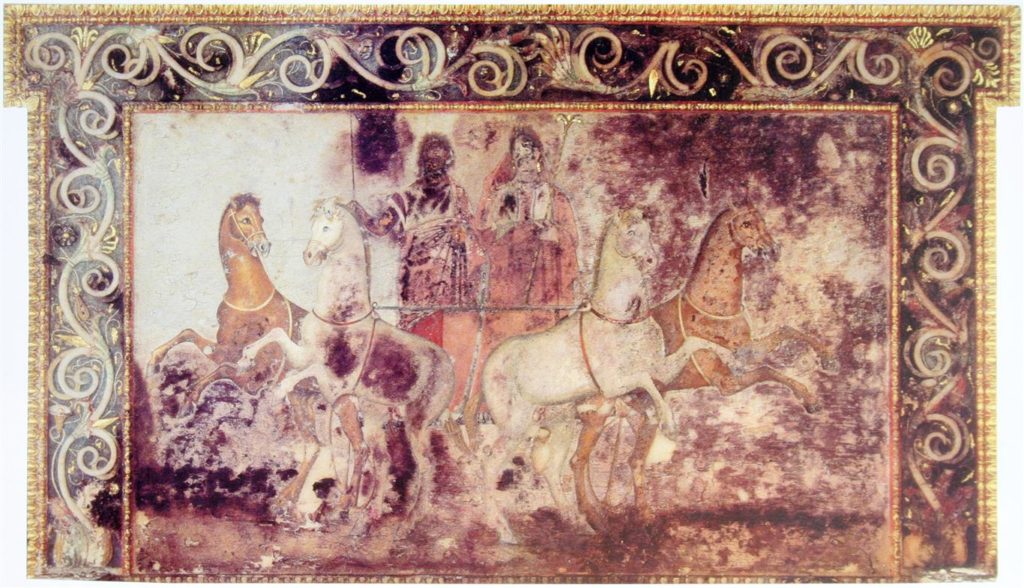Imagine that your life is threatened, and in order to escape the threat, you must create another identity, a false cover. In a way, this is what most of us do as we grow up, and seek to fit into the world. All too often, we think this false cover is who we really are. But in reality, there is much more inside of us than we included in our disguise, and these parts are crying out to be recognized. We write about this challenge in our section “Facing A Deeper Truth,” in our book Into the Heart of the Feminine, and we would like to share this with you:
Facing a Deeper Truth
Deep beneath the systems of order in our organized lives, stormy forces are often at work. We see these forces in Margaretʼs story. Margaret came from a life that seemed ideal from an everyday perspective, and yet it became the example I would use of a womanʼs direct encounter with the Death Mother.
Mythical kingdoms symbolize the deeper forces in our personalities-such as Inannaʼs tempestuous journey into the underworld or our glimpses into Greek mythologyʼs underworld, with its passionate lord, Hades, and his bride, Persephone, who preside over the kingdom of the past and the ghosts of our ancestors. Fairy tales show us the stories of violent fathers, sick kings, absent queens, stepmothers, dwarfs, heroes, and magical creatures-all carrying on lives in our unconscious that parallel the daily lives of our conscious personalities. These little kingdoms of alternative consciousness, emotions, values, and ideas maintain their existence, often waiting for us to search them out and become aware of the tremendous power they may be wielding in our emotional processes, relationships, and the directions of our lives.
Jung developed an approach that lends clarity and organization to our study of the unconscious and the forces that move us. He described the foundation of these forces in his work on complexes, which we will investigate more deeply in the next chapter. He used myths and fairy tales to help us understand how these complexes are formed, how they act, and how they can be transformed and integrated in our inner work. We will consider the myth of Medusa as a guide to the process of transforming our experience of the Death Mother.
Frequently, we try as hard as we can to live in a “normal” state of maturity as defined by the conventional models of existence we learned from our families and society. Or we try to rebel against these models, seeking a more fulfilling way of life that we are unable to attain because we have not yet faced the reality that shaped us, hurt us, dominated us, and is still blocking our path, like an avalanche on a mountain trail. Let us return to the story of Margaret for a moment. When Margaret tried to live a conventional life or to rebel against the cold propriety and expectations of her mother, she ended up weeping and weeping, and the more she wept, the more furious she became at herself and at life. Something deep inside her was calling out for recognition and healing.
As we recognize our painful inner voices, it will comfort us to remember that the healing purpose of learning to understand ourselves in more profound, heartfelt ways isnʼt just to resolve our conflicts or to deal with our neuroses. Our deeper purpose is to join forces with the well of life and renewal within us. Individuation, as Jung called this process, connects us to the source of our evolving strength, wisdom, love, and other potentials. By embarking on this inner journey, we begin accepting our reality, healing ourselves, and opening the door to our true capacities for living.
Margaret was frightened and ashamed of her tendency to break down in tears in front of other people. She was shocked at the vehemence of the exclamations that poured out of her in my office. Choking back her tears, she said, “I just canʼt do it anymore. I canʼt get my life together. I yell at my children, my marriage stinks, and I donʼt know why my husband stays with me. I donʼt like him and I donʼt like myself. I hate the way I look. I hate looking crazy. I feel stupid, and the harder I try to . . . fix things, the worse it gets.”
When Margaret stopped blaming only herself, she was able to begin explaining her anger with her parents. Previously, she had been directing her anger and fury inward, faulting herself for not being lovable and for not living up to their expectations. Yet Margaret had been unaware of how much she was blaming herself. She had resented her motherʼs relentless expectations, which always seemed to exceed anything Margaret could achieve. Margaretʼs experiences with her mother, her motherʼs coldness and disdain, had left her furious and had sabotaged her capacity to give and receive love. She was also devastated by her fatherʼs absence in general and his complicity with her mother when he was present. Bit by bit, Margaret began to realize that what looked like a childhood supplied with the “right stuff” was actually full of damaging events that had fashioned the plot of her lifeʼs story so far.
As Margaret learned more about herself, she began to grudgingly respect her rage and despair as turning points that forced her to begin the efforts to open up her life, to heal, and to grow, rather than to give up.
art credit: A Fresco Showing Hades and Persephone Riding in a Chariot, from the Tomb of Queen Eurydice I of Macedon at Vergina, Greece, c.350 BC
Articles by Drs. Bud and Massimilla Harris, Book Excerpts and Resources

Comments are closed.